Space, shape and measurement: Calculate the surface area and volume of two- and three-dimensional shapes
Unit 2: Finding the surface area of 3-D shapes
Natashia Bearam-Edmunds
Unit outcomes
By the end of this unit you will be able to:
- Apply the appropriate formulae to find the surface area of:
- right pyramids (with square, equilateral triangle or regular hexagonal bases)
- right cones
- spheres.
- Determine and calculate the surface area of combinations of these geometric objects.
What you should know
Before you start this unit, make sure you can:
- find the surface area of right prisms. You can revise surface area of prisms in level 2 subject outcome 3.2 unit 3.
Introduction
The total surface area (TSA) of a 3-D shape is the sum of the areas of all its exposed faces (or outer surfaces). In unit 1 of this subject outcome we calculated the volume of right pyramids, cones and spheres. Now, we will find the surface area of these shapes.
Below is a useful table of formulae we can use to find the surface area of right pyramids, cones and spheres.
| Square pyramid | 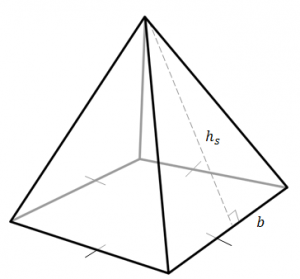 |
[latex]\scriptsize \displaystyle \begin{align*}\text{TSA}&=\text{area of base + area of triangular sides}\\&={{b}^{2}}+\left( {4\displaystyle \frac{1}{2}b{{h}_{s}}\text{ }} \right)\text{ }{{h}_{s}}\text{ is the slant height}\\&=b(b+2{{h}_{s}})\end{align*}[/latex] |
| Triangular pyramid/ tetrahedron |
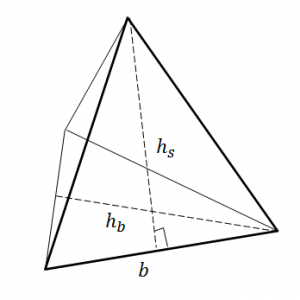 |
[latex]\scriptsize \begin{align*}\text{TSA}&=\text{area of base + area of triangular sides}\\&=\left( {\displaystyle \frac{1}{2}b\times {{h}_{b}}} \right)+3\left( {\displaystyle \frac{1}{2}b\times {{h}_{s}}\text{ }} \right)\end{align*}[/latex] |
| Hexagonal pyramid |  |
[latex]\scriptsize \displaystyle \begin{align*}\text{TSA}&=\text{area of base + area of triangular sides}\\&=\displaystyle \frac{{3\sqrt{3}}}{2}{{b}^{2}}+6\left( {\displaystyle \frac{1}{2}b\cdot {{h}_{s}}} \right)\\&=\displaystyle \frac{{3\sqrt{3}}}{2}{{b}^{2}}+3b\cdot {{h}_{s}}\\&=3b\left( {\displaystyle \frac{{\sqrt{3}}}{2}b+{{h}_{s}}} \right)\end{align*}[/latex] |
| Cone | 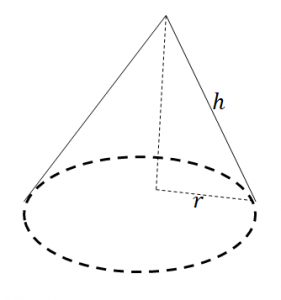 |
[latex]\scriptsize \begin{align*}\text{TSA}&=\text{area of base + area of walls}\\&=\pi {{r}^{2}}+\displaystyle \frac{1}{2}\times 2\pi rh\\&=\pi r(r+h)\end{align*}[/latex] |
| Sphere | 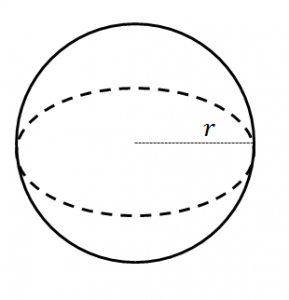 |
[latex]\scriptsize \text{TSA}=4\pi {{r}^{2}}[/latex] |
Example 2.1
Find the surface area of the following pyramid (correct to two decimal places):
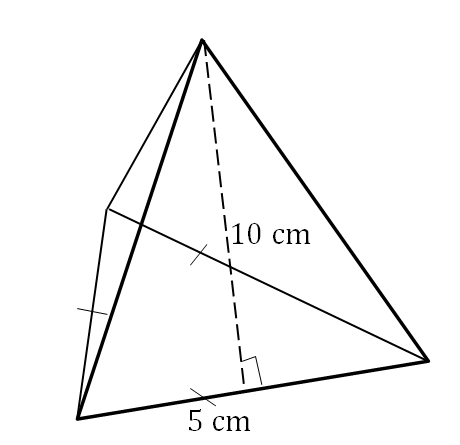
Solution
Here we are given a triangular pyramid with the slant height and length of a base side. If we use the formula:
[latex]\scriptsize \begin{align*}\text{TSA}&=\text{area of base + area of triangular sides}\\&=(\displaystyle \frac{1}{2}b\times {{h}_{b}})+3(\displaystyle \frac{1}{2}b\times {{h}_{s}})\text{ }\end{align*}[/latex]
we see that we need to calculate the length of the height of the base triangle to find the area of the base triangle.
Step 1: Find the area of the base
[latex]\scriptsize \text{Area of base triangle}=(\displaystyle \frac{1}{2}b\times {{h}_{b}})[/latex]
To find the height of the base triangle [latex]\scriptsize {{h}_{b}}[/latex] we use the theorem of Pythagoras.
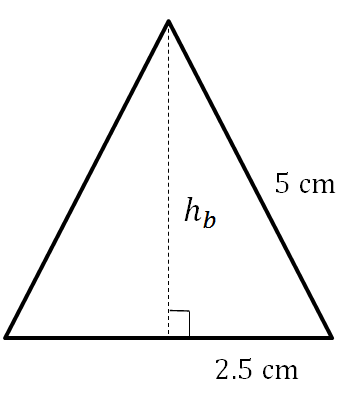
Note that: the altitude of an equilateral triangle bisects its base.
[latex]\scriptsize \begin{align*}{{5}^{2}}&={{h}_{b}}^{2}+{{(2.5)}^{2}}\\{{h}_{b}}&=\sqrt{{{{5}^{2}}-{{{(2.5)}}^{2}}}}\\&=\sqrt{{\displaystyle \frac{{75}}{4}}}\\&=\displaystyle \frac{{5\sqrt{3}}}{2}\end{align*}[/latex]
[latex]\scriptsize \begin{align*}\text{Area of base triangle}&=\left( {\displaystyle \frac{1}{2}(5)\times \displaystyle \frac{{5\sqrt{3}}}{2}} \right)\\&=\displaystyle \frac{{25\sqrt{3}}}{4}\text{ c}{{\text{m}}^{2}}\end{align*}[/latex]
Step 2: Find the area of the sides
[latex]\scriptsize \begin{align*}\text{Area of sides}&=3\left( {\displaystyle \frac{1}{2}b\times {{h}_{s}}\text{ }} \right)\\&=3\left( {\displaystyle \frac{1}{2}(5)\times 10\text{ }} \right)\\&=75\text{ c}{{\text{m}}^{2}}\end{align*}[/latex]
Step 3: Find the sum of the areas to find the total surface area
[latex]\scriptsize \displaystyle \frac{{25\sqrt{3}}}{4}\text{ c}{{\text{m}}^{2}}+75\text{ c}{{\text{m}}^{2}}=85.83\text{ c}{{\text{m}}^{2}}[/latex]
The surface area of the triangular pyramid is [latex]\scriptsize 85.83\text{ c}{{\text{m}}^{2}}[/latex].
Example 2.2
Find the surface area of a square based pyramid with base length [latex]\scriptsize 6\text{ cm}[/latex] and slant height of [latex]\scriptsize 11\text{ cm}[/latex].
Solution
We use the formula:
[latex]\scriptsize \displaystyle \begin{align*}\text{TSA}&=\text{area of base + area of triangular sides}\\&={{b}^{2}}+4\left( {\displaystyle \frac{1}{2}b{{h}_{s}}\text{ }} \right)\text{ }{{h}_{s}}\text{ is the slant height}\\&=b(b+2{{h}_{s}})\end{align*}[/latex]
[latex]\scriptsize \displaystyle b=6\text{ cm }{{h}_{s}}=11\text{ cm}[/latex]
[latex]\scriptsize \displaystyle \begin{align*}\text{TSA}&=b(b+2{{h}_{s}})\\&=6(6+2\times 11)\\&=168\text{ c}{{\text{m}}^{2}}\end{align*}[/latex]
The surface area of the square based pyramid is [latex]\scriptsize \displaystyle 168\text{ c}{{\text{m}}^{2}}[/latex].
Example 2.3
Find the surface area of the following cone (correct to 1 decimal place):
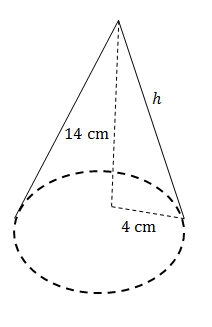
Solution
Write down the formula.
[latex]\scriptsize \begin{align*}\text{TSA}&=\text{area of base + area of walls}\\&=\pi {{r}^{2}}+\displaystyle \frac{1}{2}\times 2\pi rh\\&=\pi r(r+h)\end{align*}[/latex]
To find the slant height we use the theorem of Pythagoras.
[latex]\scriptsize \begin{align*}{{h}^{2}}&={{14}^{2}}+{{4}^{2}}\\&=212\\h&=2\sqrt{{53}}\end{align*}[/latex]
Substitute the values for [latex]\scriptsize \displaystyle r[/latex] and [latex]\scriptsize \displaystyle h[/latex] into the formula.
[latex]\scriptsize \begin{align*}\text{TSA}&=\pi r(r+h)\\&=\pi (4)(4+2\sqrt{{53}})\\&=233.2\text{ c}{{\text{m}}^{2}}\end{align*}[/latex]
The surface area of the cone is [latex]\scriptsize 233.2\text{ c}{{\text{m}}^{2}}[/latex].
Exercise 2.1
- The Southern African Large Telescope (SALT) is housed in a cylindrical building with a domed roof in the shape of a hemisphere. The height of the building’s wall is [latex]\scriptsize \displaystyle 17\text{ m}[/latex] and the diameter is [latex]\scriptsize \displaystyle 26\text{ m}[/latex].
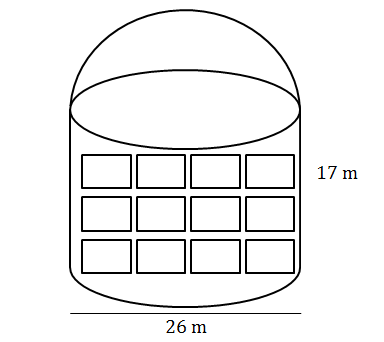
- Calculate the total surface area of the building. (HINT: The surface area of a hemisphere is half the surface area of a sphere).
- Calculate the total volume of the building.
- An ice-cream cone has a diameter of [latex]\scriptsize \displaystyle 52.4\text{ mm}[/latex] and a total height of [latex]\scriptsize \displaystyle 146\text{ mm}[/latex]. Calculate the surface area of the ice-cream and the cone.
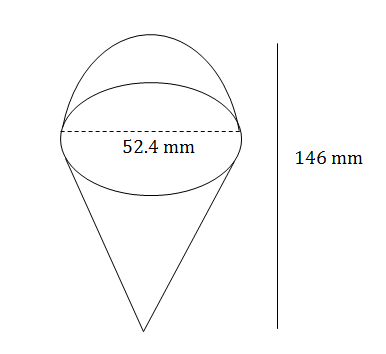
- A pyramid with a square base has base sides each of [latex]\scriptsize \displaystyle 4[/latex] units long. The vertical height of the pyramid is [latex]\scriptsize 8.77[/latex] units, and the slant height of the pyramid is [latex]\scriptsize \displaystyle 9[/latex] units. Determine the surface area of the pyramid.
The full solutions are at the end of the unit.
Summary
In this unit you have learnt the following:
- How to find the surface area of right pyramids.
- How to find the surface area of cones.
- How to find the surface area of spheres.
Unit 2: Assessment
Suggested time to complete: 20 minutes
- The solid below is made of a cube and a square pyramid:

- Find the surface area of the solid. Give your answers to two decimal places.
- Now determine the volume of the shape. Give your answer to the nearest integer value.
- Find the surface area of the following capsule:
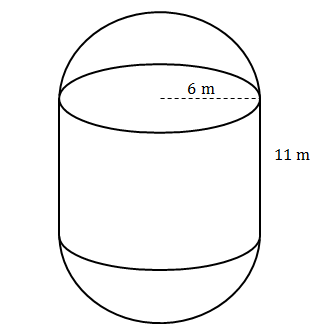
- Sammy needs to cover a pyramid with a hexagonal base and sides of length of [latex]\scriptsize 550\text{ mm}[/latex]. The slant height of the pyramid is [latex]\scriptsize 200\text{ mm}[/latex]. If the cost of the material needed to cover the pyramid is [latex]\scriptsize \text{R}100[/latex] per square metre. What is the total cost to cover the pyramid?
The full solutions are at the end of the unit.
Unit 2: Solutions
Exercise 2.1
- .
- [latex]\scriptsize \displaystyle \text{Total surface area }\!\!~\!\!\text{ }=\text{surface area of dome}+\text{surface area of cylinder}[/latex]
[latex]\scriptsize \begin{align*}\text{TSA}&=\displaystyle \frac{1}{2}(4\pi {{r}^{2}})+2\pi rh\\&=\displaystyle \frac{1}{2}[4\pi {{(13)}^{2}}]+2\pi (13)(17)\\&=780\pi \text{ }{{\text{m}}^{2}}\\&=2\text{ }450\text{ }{{\text{m}}^{2}}\end{align*}[/latex] - [latex]\scriptsize \displaystyle \text{Total volume}=\text{volume of dome}+\text{volume of cylinder}[/latex]
[latex]\scriptsize \begin{align*}V&=\displaystyle \frac{1}{2}\left( {\displaystyle \frac{4}{3}\pi {{r}^{3}}} \right)+\pi {{r}^{2}}h\\&=\displaystyle \frac{2}{3}\pi {{(13)}^{3}}+\pi {{(13)}^{2}}(17)\\&=13\text{ 627 }{{\text{m}}^{3}}\end{align*}[/latex]
- [latex]\scriptsize \displaystyle \text{Total surface area }\!\!~\!\!\text{ }=\text{surface area of dome}+\text{surface area of cylinder}[/latex]
- .
The vertical height of the cone is [latex]\scriptsize 146\text{ mm}-52.4\text{ mm}=93.6\text{ mm}[/latex].
Work out the slant height using the theorem of Pythagoras.
[latex]\scriptsize \begin{align*}{{h}_{s}}^{2}&={{(26.2)}^{2}}+{{(93.6)}^{2}}\\{{h}_{s}}&=\sqrt{{9447.4}}\\&=97.19...\text{ mm}\end{align*}[/latex]
For the surface area of the cone we consider only the surface area of the walls that make up the cone. [latex]\scriptsize \displaystyle \text{Total surface area }\!\!~\!\!\text{ }=\text{surface area of hemisphere}+\text{surface area of cone}[/latex]
[latex]\scriptsize \displaystyle \begin{align*}\text{TSA}&=\displaystyle \frac{1}{2}(4\pi {{r}^{2}})+\pi rh\\&=\displaystyle \frac{1}{2}(4\pi {{(26.2)}^{2}})+\pi (26.2)(97.19...)\\&=12\text{ 313}\text{.35 m}{{\text{m}}^{2}}\end{align*}[/latex] - .
[latex]\scriptsize \displaystyle \begin{align*}\text{TSA}&=\text{area of base + area of triangular sides}\\&={{b}^{2}}+4(\displaystyle \frac{1}{2}b{{h}_{s}})\text{ }{{h}_{s}}\text{ is the slant height}\\&=b(b+2{{h}_{s}})\\&=4(4+2\cdot 9)\\&=88\text{ units squared }\end{align*}[/latex]
Unit 2: Assessment
- .
- Note: we must include only the exposed surfaces in the calculation of surface area.
First, find [latex]\scriptsize \displaystyle {{h}_{s}}[/latex] by using the theorem of Pythagoras.
[latex]\scriptsize 22\text{ cm}-7\text{ cm}=15\text{ cm is the vertical height of the pyramid}[/latex]
[latex]\scriptsize \displaystyle \begin{align*}{{h}_{s}}^{2}&={{15}^{2}}+{{3.5}^{2}}\\{{h}_{s}}&=\sqrt{{\displaystyle \frac{{949}}{4}}}\\&=\displaystyle \frac{{\sqrt{{949}}}}{2}\text{ cm}\end{align*}[/latex]
Next, find the total surface area.
[latex]\scriptsize \text{TSA}=\text{Surface area of square base pyramid}+\text{surface area of cube}[/latex]
[latex]\scriptsize \displaystyle \begin{align*}\text{TSA}&=4(\displaystyle \frac{1}{2}b{{h}_{s}})+[{{b}^{2}}+4bh]\\&=2(7\cdot \displaystyle \frac{{\sqrt{{949}}}}{2})+[({{7}^{2}})+4(7)7]\\&=460.64\text{ c}{{\text{m}}^{2}}\end{align*}[/latex] - [latex]\scriptsize \displaystyle \text{Total volume}=\text{volume of pyramid}+\text{volume of cube}[/latex]
[latex]\scriptsize \begin{align*}V&=\displaystyle \frac{{{{b}^{2}}h}}{3}+{{b}^{3}}\\&=\displaystyle \frac{{{{{(7)}}^{2}}(15)}}{3}+{{(7)}^{3}}\\&=588\text{ c}{{\text{m}}^{3}}\end{align*}[/latex]
- Note: we must include only the exposed surfaces in the calculation of surface area.
- [latex]\scriptsize \displaystyle \text{Total surface area }\!\!~\!\!\text{ }=\text{surface area of sphere}+\text{surface area of cylinder}[/latex]
[latex]\scriptsize \begin{align*}\text{TSA}&=4\pi {{r}^{2}}+2\pi rh\\&=4\pi {{(6)}^{2}}+2\pi (6)(11)\\&=276\pi \\&=867.08\text{ }{{\text{m}}^{2}}\end{align*}[/latex] - .
[latex]\scriptsize \displaystyle \begin{align*}\text{TSA}&=\text{area of base + area of triangular sides}\\&=\displaystyle \frac{{3\sqrt{3}}}{2}{{b}^{2}}+6\left( {\displaystyle \frac{1}{2}b\cdot {{h}_{s}}} \right)\\&=\displaystyle \frac{{3\sqrt{3}}}{2}{{b}^{2}}+3b\cdot {{h}_{s}}\\&=3b\left( {\displaystyle \frac{{\sqrt{3}}}{2}b+{{h}_{s}}} \right)\\&=3(550)(\displaystyle \frac{{\sqrt{3}}}{2}(550)+200)\\&=1\text{ }115\text{ }918.05\text{ m}{{\text{m}}^{2}}\end{align*}[/latex]
.
Next, covert from [latex]\scriptsize \text{m}{{\text{m}}^{2}}[/latex] to [latex]\scriptsize {{\text{m}}^{2}}[/latex]
[latex]\scriptsize \displaystyle \begin{align*}1\text{ }{{\text{m}}^{2}}&=1\text{ }000\text{ }000\text{ m}{{\text{m}}^{2}}\\1\text{ }115\text{ }918.05\text{ m}{{\text{m}}^{2}}&=1.115...\text{ }{{\text{m}}^{2}}\end{align*}[/latex]
.
[latex]\scriptsize \begin{align*}\text{Total cost}&=100\times 1.\text{ }115...\\&=\text{R}111.59\end{align*}[/latex]
Media Attributions
- Fig 1 Square pyramid © "svg-WikimediaCommons " is licensed under a Public Domain license
- Fig 2 Triangular pyramid © DHET is licensed under a CC BY (Attribution) license
- Fig 3 Hex pyramid © DHET is licensed under a CC BY (Attribution) license
- Fig 4 cone © DHET is licensed under a CC BY (Attribution) license
- Fig 5 sphere © DHET is licensed under a CC BY (Attribution) license
- Fig 6 Example 2.1 © DHET is licensed under a CC BY (Attribution) license
- Fig 7 Example 2.1 © DHET is licensed under a CC BY (Attribution) license
- Fig 8 Example 2.3 © DHET is licensed under a CC BY (Attribution) license
- Fig 9 Ex 2.1 Q1 © DHET is licensed under a CC BY (Attribution) license
- Fig 10 Ex 2.1 Q2 © DHET is licensed under a CC BY (Attribution) license
- Fig 11 Assess Q1 © DHET is licensed under a CC BY (Attribution) license
- Fig 12 Assess Q2 © DHET is licensed under a CC BY (Attribution) license
